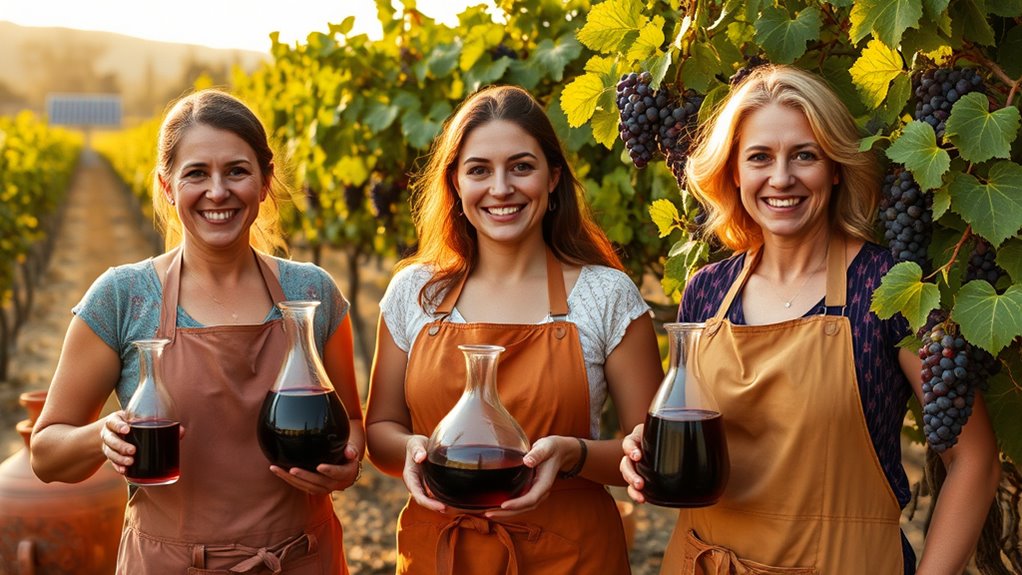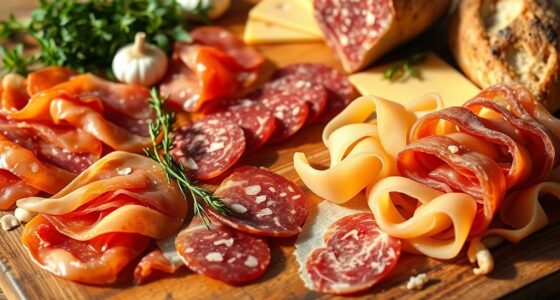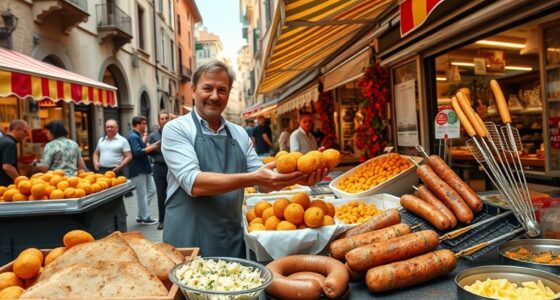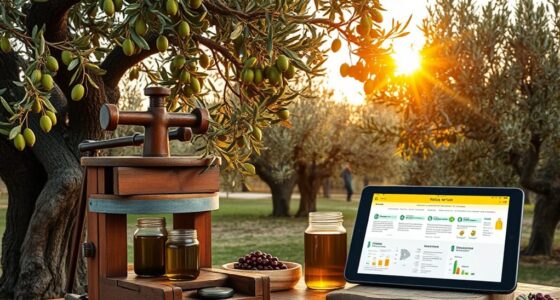Women winemakers in Italy are revolutionizing the industry with sustainable practices and innovative vineyard techniques. They blend tradition with modern methods, emphasizing organic farming, soil health, and water conservation. Their leadership not only preserves Italy’s rich wine heritage but also enhances its global reputation. By championing inclusion and eco-friendly practices, they’re shaping the future of Italian wine. Discover how their trailblazing efforts continue to redefine the landscape, inspiring future generations along the way.
Key Takeaways
- Women winemakers in Italy are leading the shift toward sustainable viticulture through organic farming and eco-friendly vineyard practices.
- They combine traditional techniques with innovative methods like cover cropping and water conservation to promote ecological balance.
- These women are redefining Italy’s wine heritage by emphasizing biodiversity and land preservation for future generations.
- Their leadership inspires a more inclusive industry, encouraging new generations to pursue sustainable winemaking careers.
- Italian women winemakers are enhancing the global reputation of Italian wines through authentic, environmentally responsible practices.
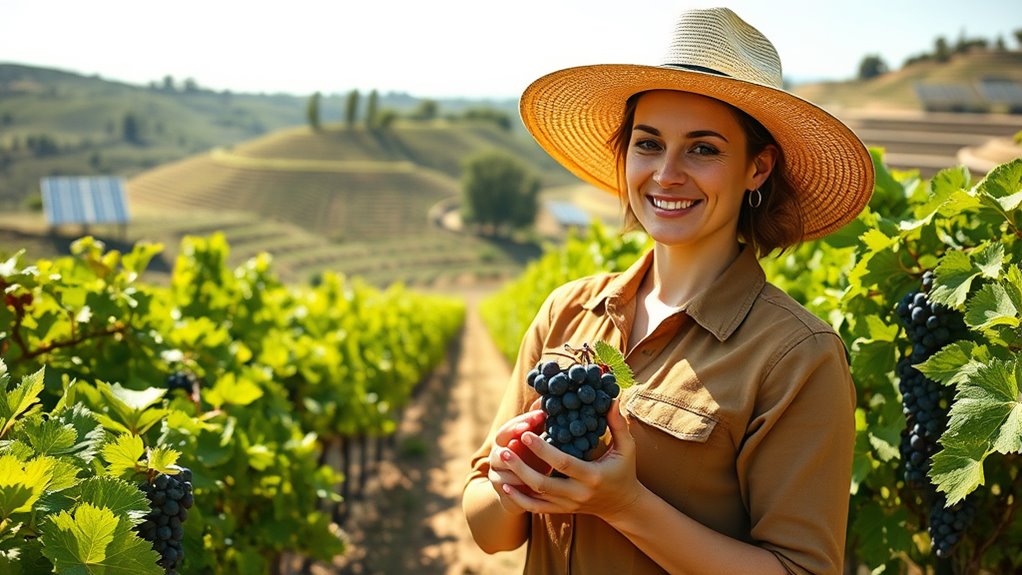
Italy’s wine industry has long been celebrated for its rich traditions and exceptional quality, yet women winemakers are increasingly reshaping its landscape. You might not realize it, but these women are at the forefront of preserving Italy’s wine heritage while pushing the boundaries of vineyard innovation. Their influence is evident in the way they blend age-old techniques with modern, sustainable practices, ensuring that Italy’s wine tradition endures for generations to come. As you explore the vineyards and tasting rooms, you’ll notice that these women aren’t just participating—they’re leading the charge towards a more inclusive and environmentally conscious future.
In a landscape historically dominated by men, women winemakers are carving out space through their dedication to both tradition and innovation. They understand that maintaining Italy’s wine heritage isn’t just about respecting the past; it’s about actively evolving it. These women often introduce new methods that reduce chemical use, incorporate organic farming practices, and promote biodiversity in the vineyards. Their commitment to vineyard innovation isn’t merely a trend but a necessity for sustainable growth, helping protect the land and the quality of the grapes they nurture. This approach resonates deeply with connoisseurs who value authenticity and ecological responsibility.
Many women winemakers are also redefining how Italy’s wines are perceived globally. They bring fresh perspectives to classic varieties like Sangiovese, Nebbiolo, and Vermentino, infusing new life into traditional styles. Their focus on sustainable viticulture means that every bottle you taste is a tribute to their dedication to the environment and to Italy’s storied wine culture. You’ll find that their work often involves experimenting with cover crops, composting, and water conservation techniques—each step designed to improve soil health and reduce the carbon footprint. These innovations ensure that Italy’s winemaking continues to thrive without compromising the land’s integrity. Moreover, adopting cultural intelligence strategies allows them to effectively communicate and share their sustainable practices on an international stage.
Their leadership extends beyond the vineyard, inspiring a new generation of women to pursue their passion in wine. By championing sustainable practices and embracing innovation, they’re not only honoring Italy’s wine heritage but also shaping its future. As you raise a glass, know that behind every sip is a story of resilience, tradition, and trailblazing change driven by women who are redefining Italy’s vinicultural identity. Their influence proves that the future of Italian wine is brighter and more inclusive, rooted in respect for the land and a bold vision for what’s possible.
Frequently Asked Questions
How Do Women Winemakers Influence Sustainable Wine Practices?
Women winemakers influence sustainable wine practices by adopting organic practices and innovative techniques. You see them leading the way, implementing eco-friendly methods that reduce chemical use and promote biodiversity. Their creativity drives new approaches, like natural fermentation and water conservation, setting higher standards for sustainability. By prioritizing environmental health, you help shape a future where winemaking balances tradition with responsible innovation, inspiring others to follow their example.
What Challenges Do Women Face in Italy’s Winemaking Industry?
You face challenges like gender stereotypes that often overlook women’s expertise and leadership in winemaking. Access to resources can also be limited, making it harder to establish your vineyard or gain funding. Despite these obstacles, many women persist, breaking barriers and redefining the industry. Your resilience and dedication help challenge outdated norms, paving the way for greater gender equality and sustainable practices in Italy’s winemaking industry.
Are There Specific Regions in Italy Known for Women-Led Wineries?
Remarkably, Tuscany and Lombardy are renowned for female-led vineyards that embrace regional wine traditions. In these regions, women actively shape winemaking, blending age-old practices with innovative sustainability efforts. You’ll find that these women-led wineries not only honor Italy’s rich viticultural history but also challenge norms, making them standout examples of empowerment. Their dedication helps preserve regional flavors while pioneering sustainable practices that inspire others across Italy.
How Do Women Winemakers Incorporate Traditional Techniques Sustainably?
You incorporate traditional techniques sustainably by focusing on heritage preservation and organic farming methods. By respecting age-old practices, you maintain the authenticity of your wine, ensuring cultural continuity. Using organic farming, you reduce chemical use, protect the environment, and promote soil health. These approaches allow you to craft high-quality wines while supporting sustainability, honoring Italy’s winemaking heritage, and ensuring the land remains vibrant for future generations.
What Awards or Recognitions Have Women Winemakers Received?
You’ll find that women winemakers in Italy have earned notable industry recognition, including prestigious awards like the Tre Bicchieri and various organic certification honors. Their achievements highlight progress in gender equity within the industry, showcasing their skill and dedication. These accolades not only celebrate their craftsmanship but also promote greater visibility for women in winemaking, inspiring future generations to pursue excellence and leadership in sustainable viticulture.
Conclusion
As you explore Italy’s winemaking scene, remember that women now make up over 30% of the country’s winemakers, breaking barriers and leading the way in sustainable practices. Their pioneering efforts not only preserve Italy’s rich wine heritage but also set new standards for eco-friendly viticulture. By supporting these women, you’re helping to foster innovation and sustainability in the industry, ensuring that Italy’s celebrated wines continue to thrive for generations to come.
